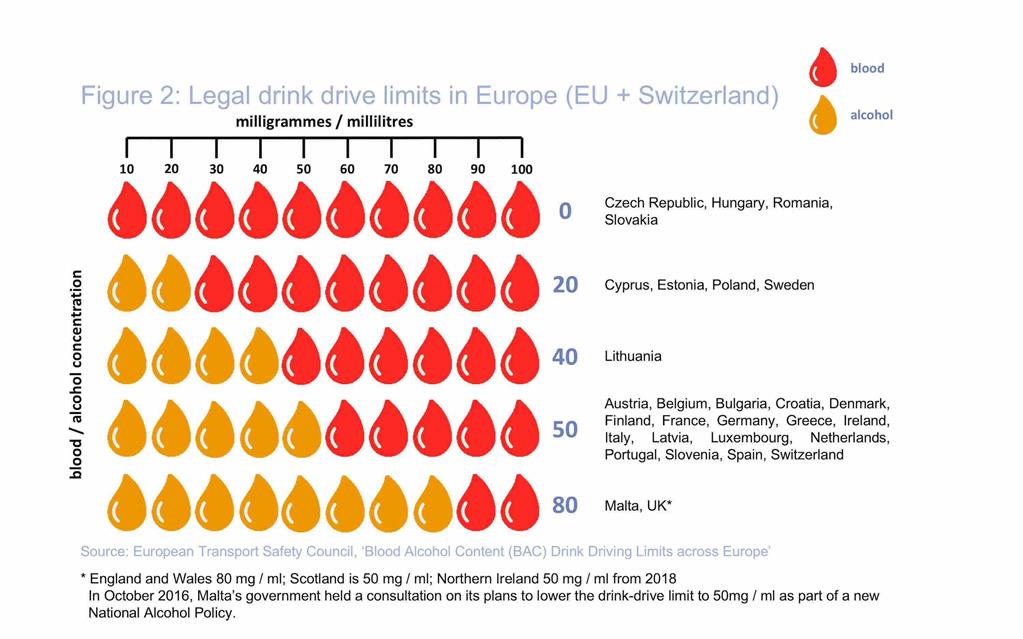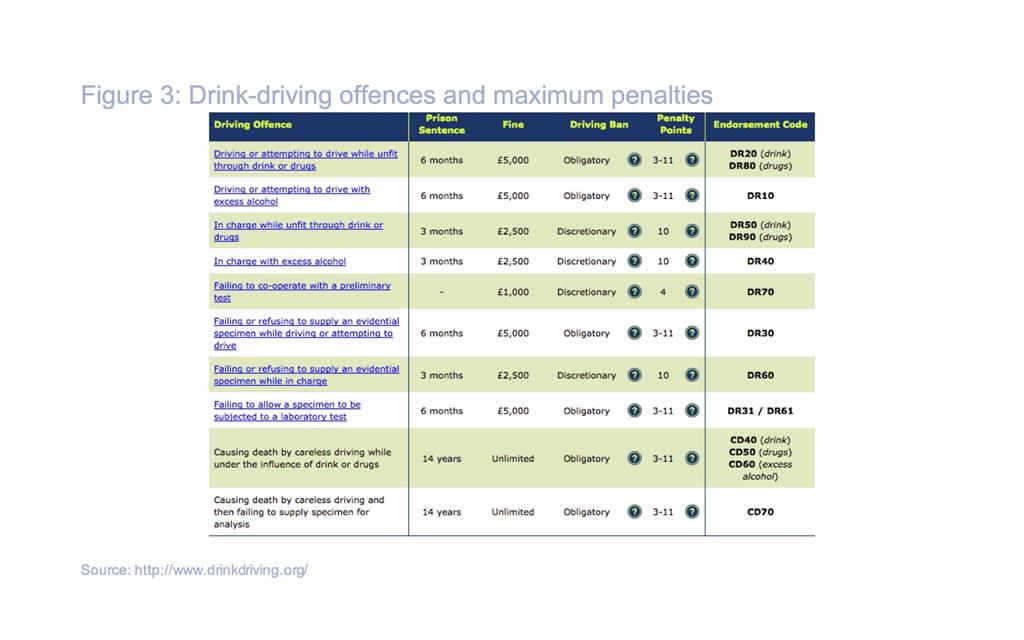Legal limits: UK
The legal blood-alcohol limit for driving in England, Wales and
Northern Ireland is 80 milligrammes of alcohol (80mg) for every 100
millilitres, equivalent to 107 milligrammes of alcohol in 100
millilitres of urine, or 35 micrograms of alcohol in 100 millilitres of
breath.[1]
Legal limits: The European Union (EU)
As of January 2015, England, Wales and Northern Ireland share the
joint highest blood-alcohol concentration (BAC) limit for motorcar
drivers out of all 28 Member States, along with Malta. Figure 2 displays
a list of BAC limits for EU countries expressed in milligrammes of
ethanol per millilitre of blood.As figure 2 shows, Scotland’s drink-drive limit differs from the rest of the UK; the drink-drive limit was lowered in December 2014 to 50 milligrammes of alcohol for every 100 millilitres of blood. The Northern Ireland Assembly has followed suit, passing a Road Traffic (Amendment) Bill (to be implemented in 2018) that will introduce two new lower drink driving limits – 50mg / 100ml for all drivers and 20mg / 100ml for novice and professional drivers.[3]
Offences
Under the Road Traffic Act 1988, the following acts are deemed illegal in the UK and are given the following penalties:Under the amendments made to the Act in 1991, a drink-driver may also be prosecuted in the event of a fatality arising from a motoring accident. These offences are given the CD code, which stands for ‘Careless Driving’.
A drink-driving offence will stay on your licence for a period of up to 11 years from the date of conviction. The exact time period will depend on the particular drink-driving related offence you are convicted of (see figure 4).
Current legislation contains provisions for serious – including repeat – drink-drive offenders to be made to retake the driving test at the end of their period of disqualification, under the Road Safety Act 2006. It also makes provisions for the courts, when imposing disqualification as a penalty, to order a reduced period of disqualification if it also makes an order requiring the offender to comply with the conditions of an alcohol ignition interlock programme. According to the Ministry of Justice data, in 2011, the average custodial sentence length for those convicted of causing death by dangerous driving was over 4 years.[4]
[1] www.gov.uk (January 2015) ‘The drink drive limit’
[2] Home Office circular 46/1983 <http://www.cps.gov.uk/legal/assets/uploads/files/home_office_circular_46_-_1983.pdf>; from The Crown Prosecution Service, ‘Drink Driving Offences – The Law’ <http://www.cps.gov.uk/legal/p_to_r/road_traffic_offences_drink_driving/index.html#a14>
[3] Northern Ireland Assembly ‘Road Traffic (Amendment) Bill’ <http://bit.ly/1HXvwB2>
[4] www.parliament.uk (May 2013), ‘HC Deb, c878’, Road Traffic Offences (Sentencing) <http://bit.ly/1XqMod6>
ΠΗΓΗ: http://www.ias.org.uk
[2] Home Office circular 46/1983 <http://www.cps.gov.uk/legal/assets/uploads/files/home_office_circular_46_-_1983.pdf>; from The Crown Prosecution Service, ‘Drink Driving Offences – The Law’ <http://www.cps.gov.uk/legal/p_to_r/road_traffic_offences_drink_driving/index.html#a14>
[3] Northern Ireland Assembly ‘Road Traffic (Amendment) Bill’ <http://bit.ly/1HXvwB2>
[4] www.parliament.uk (May 2013), ‘HC Deb, c878’, Road Traffic Offences (Sentencing) <http://bit.ly/1XqMod6>
ΠΗΓΗ: http://www.ias.org.uk




Δεν υπάρχουν σχόλια:
Δημοσίευση σχολίου